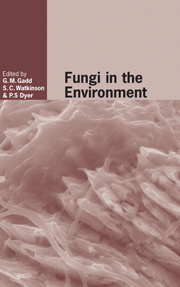Book contents
- Frontmatter
- Contents
- List of contributors
- Preface
- I Imaging and modelling of fungi in the environment
- 1 Imaging complex nutrient dynamics in mycelial networks
- 2 Natural history of the fungal hypha: how Woronin bodies support a multicellular lifestyle
- 3 Environmental sensing and the filamentous fungal lifestyle
- 4 Berkeley Award Lecture: Mathematical modelling of the form and function of fungal mycelia
- II Functional ecology of saprotrophic fungi
- III Mutualistic interactions in the environment
- IV Pathogenic interactions in the environment
- V Environmental population genetics of fungi
- VI Molecular ecology of fungi in the environment
- Index
- References
3 - Environmental sensing and the filamentous fungal lifestyle
from I - Imaging and modelling of fungi in the environment
Published online by Cambridge University Press: 03 November 2009
- Frontmatter
- Contents
- List of contributors
- Preface
- I Imaging and modelling of fungi in the environment
- 1 Imaging complex nutrient dynamics in mycelial networks
- 2 Natural history of the fungal hypha: how Woronin bodies support a multicellular lifestyle
- 3 Environmental sensing and the filamentous fungal lifestyle
- 4 Berkeley Award Lecture: Mathematical modelling of the form and function of fungal mycelia
- II Functional ecology of saprotrophic fungi
- III Mutualistic interactions in the environment
- IV Pathogenic interactions in the environment
- V Environmental population genetics of fungi
- VI Molecular ecology of fungi in the environment
- Index
- References
Summary
Introduction
The majority of fungi have a filamentous lifestyle. The evolution of the hypha has been pivotal to the success of filamentous fungi and in determining the uniqueness of their lifestyle. It has also had important consequences in determining the modes of morphogenesis of filamentous fungi, and how they operate as non-motile, heterotrophic organisms (Read, 1994). This review focuses on hyphal and colony morphogenesis and how it is influenced by environmental signals in the context of the filamentous fungal lifestyle.
The supracellular, cellular and multicellular nature of filamentous fungi
The defining cellular element of the filamentous fungi is the hypha (Figs. 3.1–3.6). Hyphae possess a unique combination of structural, behavioural and functional attributes that clearly distinguish them from uninucleate animal and plant cells. The vegetative hypha is a tip-growing cellular element (Harris et al., 2005) (Figs. 3.1, 3.2) that undergoes regular branching (Trinci, 1983; Turner & Harris, 1997) (Figs. 3.3, 3.4), is typically multinucleate (Fig. 3.3) (Freitag et al., 2004), and possesses incomplete cross-walls (septa) which, when open, allow movement of cytoplasm and organelles between hyphal compartments (Harris, 2001) (Fig. 3.2). In sub-peripheral regions of the colony, hyphae frequently fuse with one another (Read & Roca, 2006) (Fig. 3.3) and septal pores often become blocked (Gull, 1978) (Fig. 3.2). Vegetative hyphae thus have a supracellular nature because they are part of a network of interconnected hyphal compartments and hyphae within the colony (Fig. 3.1).
- Type
- Chapter
- Information
- Fungi in the Environment , pp. 38 - 57Publisher: Cambridge University PressPrint publication year: 2007
References
- 6
- Cited by



